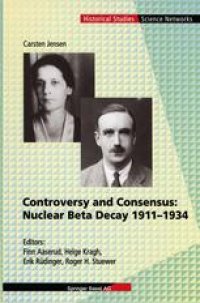
Ebook: Controversy and Consensus: Nuclear Beta Decay 1911–1934
- Genre: Physics
- Tags: Physics general
- Series: Science Networks · Historical Studies 24
- Year: 2000
- Publisher: Birkhäuser Basel
- Edition: 1
- Language: English
- pdf
To all four of us, Carsten was the best possible friend and colleague. To Finn, he was a fellow student in the history of science for several years at the Niels Bohr Institute; to Relge, he was a welcome resource for personal and intellectual interac tion in an otherwise less than fertile environment for the history of science; Roger was Carsten's friend and advisor, not least in the development of the dissertation on which the present book is based; and as director of the Niels Bohr Archive, Erik was his main advisor in his historical work. Because he was the person closest to Carsten's work on his Ph. D. dissertation on the history of beta decay, on which the present book is based, it is only fitting that Erik stands as single author of the words in Carsten's memory at the very beginning of this book. Before his untimely death shortly after the completion of the Ph. D. disser tation, Carsten had himself plans to develop the dissertation into a book. Being a true perfectionist, he wanted to rework the manuscript substantively, especially with regard to relating it to the broader discussion among historians of science.
The book describes in detail the considerable efforts by theoretical and experimental physicists to understand the beta spectra of atomic nuclei. After a brief prehistory, the main narrative spans the period from 1911, when Rutherford and collaborators in Manchester established that the atom had an extremely massive nucleus, until 1934, when the question of beta decay was settled theoretically by Fermi and others. It includes prominently the intense controversy over several years between Lise Meitner from Germany and C. D. Ellis from England about the origin of beta rays. Aside from providing a rich story in its own right, the narrative is uniquely suited to illuminate currently debated issues such as the relationship between theory and experiment, scientific controversy, the role and resolution of anomalies, and national differences in the approach to science.
The book describes in detail the considerable efforts by theoretical and experimental physicists to understand the beta spectra of atomic nuclei. After a brief prehistory, the main narrative spans the period from 1911, when Rutherford and collaborators in Manchester established that the atom had an extremely massive nucleus, until 1934, when the question of beta decay was settled theoretically by Fermi and others. It includes prominently the intense controversy over several years between Lise Meitner from Germany and C. D. Ellis from England about the origin of beta rays. Aside from providing a rich story in its own right, the narrative is uniquely suited to illuminate currently debated issues such as the relationship between theory and experiment, scientific controversy, the role and resolution of anomalies, and national differences in the approach to science.
Content:
Front Matter....Pages i-xvii
Prelude: Beta-Spectrum Research in the Pre-Nuclear Years, 1900–1911....Pages 1-28
The Origin of Beta Rays, and the Growing Complexity of Their Spectrum: The Rutherford Era, 1911–1919....Pages 29-53
The Rise of a Controversy: Ellis, Meitner and Smekal Advance Different Beta-Spectrum Theories, 1920–1922....Pages 55-93
Secondary Effects and Order of Emission: Two Main Questions in the Controversy, 1923–1925....Pages 95-120
The End of the Beginning: The Controversy Enters the Decisive Phase, 1925–1929....Pages 121-143
From Anomaly to Explanation: The Continuous Beta Spectrum, 1929–1934....Pages 145-184
Towards a Theory of Internal Conversion: The Beta Line-Spectrum, 1927–1934....Pages 185-206
Summary and Conclusion....Pages 207-212
Back Matter....Pages 213-217
The book describes in detail the considerable efforts by theoretical and experimental physicists to understand the beta spectra of atomic nuclei. After a brief prehistory, the main narrative spans the period from 1911, when Rutherford and collaborators in Manchester established that the atom had an extremely massive nucleus, until 1934, when the question of beta decay was settled theoretically by Fermi and others. It includes prominently the intense controversy over several years between Lise Meitner from Germany and C. D. Ellis from England about the origin of beta rays. Aside from providing a rich story in its own right, the narrative is uniquely suited to illuminate currently debated issues such as the relationship between theory and experiment, scientific controversy, the role and resolution of anomalies, and national differences in the approach to science.
Content:
Front Matter....Pages i-xvii
Prelude: Beta-Spectrum Research in the Pre-Nuclear Years, 1900–1911....Pages 1-28
The Origin of Beta Rays, and the Growing Complexity of Their Spectrum: The Rutherford Era, 1911–1919....Pages 29-53
The Rise of a Controversy: Ellis, Meitner and Smekal Advance Different Beta-Spectrum Theories, 1920–1922....Pages 55-93
Secondary Effects and Order of Emission: Two Main Questions in the Controversy, 1923–1925....Pages 95-120
The End of the Beginning: The Controversy Enters the Decisive Phase, 1925–1929....Pages 121-143
From Anomaly to Explanation: The Continuous Beta Spectrum, 1929–1934....Pages 145-184
Towards a Theory of Internal Conversion: The Beta Line-Spectrum, 1927–1934....Pages 185-206
Summary and Conclusion....Pages 207-212
Back Matter....Pages 213-217
....